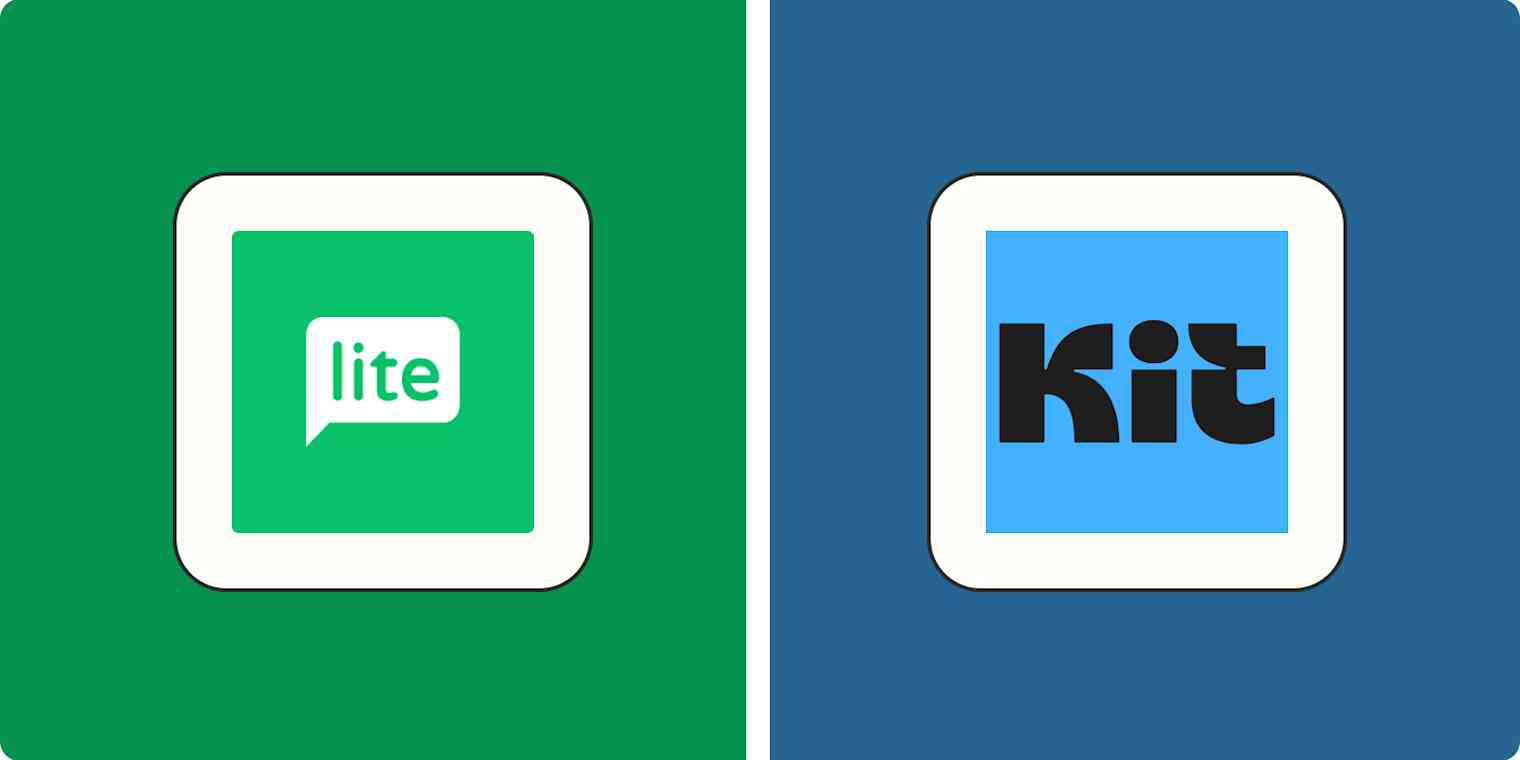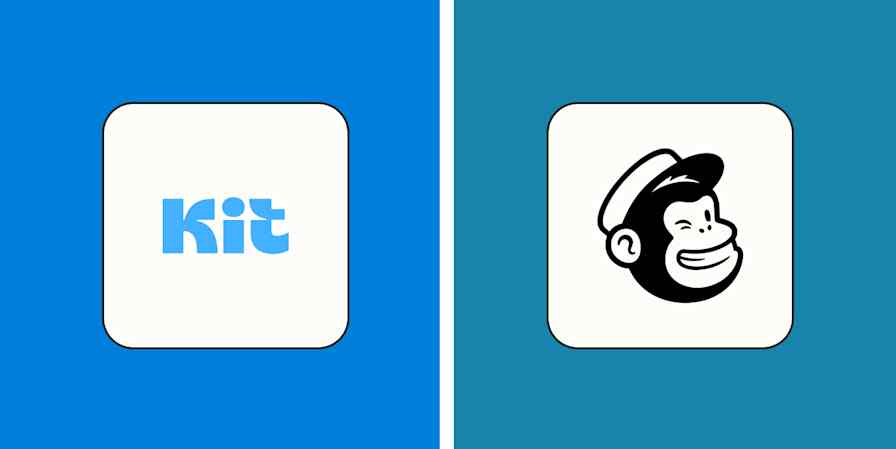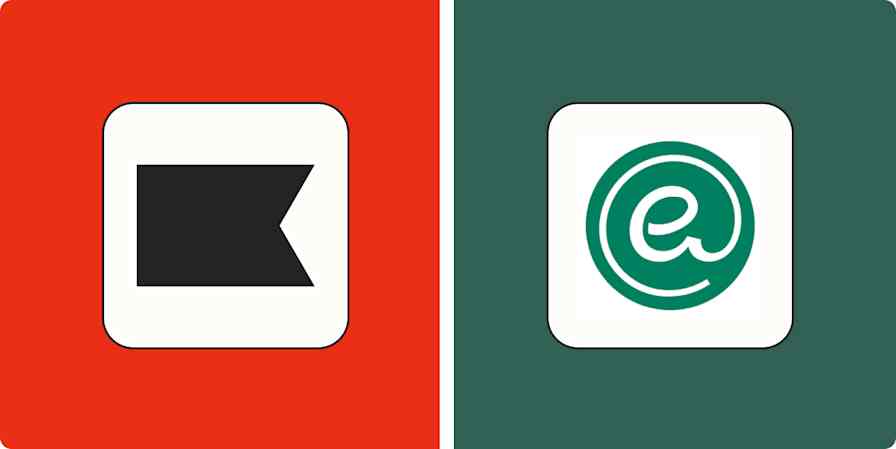Email marketing tools usually come in one of two flavors: small business or enterprise. But Kit (formerly ConvertKit) is an exception. It's laser-focused on serving online creators by giving them features they can't find anywhere else. (Kit recently rebranded from ConvertKit to reflect its positioning as an "email-first operating system for creators.") While MailerLite falls pretty neatly into the "small business" bucket, there's enough overlap between these two tools that it can be hard to decide between them.
I've used MailerLite for years and have tested Kit extensively. I spent more time in each app to compare them head to head, and here, I'll break down the pros and cons of each platform to help you decide which is best for you.
Table of contents:
Kit's segmentation features make it easier to organize your audience
MailerLite's analytics are better for most users, but Kit's Insights dashboard is more powerful
Kit has a better free plan, but MailerLite's paid plans offer excellent value
MailerLite vs. Kit at a glance
Here's a quick rundown of the difference between these two tools:
MailerLite is best for small businesses on a budget. It's easy to use but still powerful, and offers compelling design, automation, and analytics features.
Kit is designed for solo creators like authors, bloggers, coaches, course creators, musicians, newsletter creators, podcasters, and YouTubers. If you're aiming to grow and monetize your audience, you'll find an impressive set of tools to help.
| MailerLite | Kit |
|---|---|---|
Ease of use | ⭐⭐⭐⭐⭐ Easy-to-use design features, templates, and automation workflows make email marketing simple. | ⭐⭐⭐⭐ Designs aren't as customizable, and the drag-and-drop widgets are confusing to access; otherwise it's intuitive, and reusable blocks make it faster to design emails. |
Segmentation | ⭐⭐⭐ Multiple subscriber lists make organization easy, but it doesn't offer Kit's flexibility or power. | ⭐⭐⭐⭐⭐ Intuitive tagging and segmentation features allow hyper-targeted campaigns. |
Automation | ⭐⭐⭐ Automations are included for users of the free plan. Visual automation builder is capable, but it can be overkill for simpler automation needs. | ⭐⭐⭐⭐ Automations in Kit are quick to set up—with user-friendly features like "if this, then that" rules—and the visual automation builder creates powerful workflows. |
Audience growth and monetization | ⭐⭐ No built-in newsletter growth tools and weak monetization capabilities. | ⭐⭐⭐⭐⭐ Built-in recommendation engine for growth; easy to sell digital products and get sponsorships. |
Analytics | ⭐⭐⭐⭐ Only the essentials, but an excellent user interface that embeds analytics where you most need them. | ⭐⭐⭐⭐ Entry-level reporting is decent enough for most users, though not particularly in-depth. Creator Pro subscribers get a powerful Insights dashboard with eCommerce-style analytics. |
Pricing | ⭐⭐⭐⭐ A full-featured "forever free" plan; affordable paid plans (starting at $10/month for 500 subscribers) are accessible for small businesses. | ⭐⭐⭐⭐ Excellent free plan for up to 10,000 subscribers; Kit's paid plans, while good value, are around 2x pricer than MailerLite. |
Integrations | ⭐⭐⭐⭐⭐ 150+ integrations; integrates with thousands of apps via Zapier. | ⭐⭐⭐⭐⭐ 130+ integrations plus 25+ apps in Kit app store; integrates with thousands of apps via Zapier. |
MailerLite is easier to use, especially when building emails
Core to the MailerLite team's philosophy is an approach that "removes complexity while still offering advanced features." This minimalist approach works wonders from a user experience perspective: navigating MailerLite is easy, all features are where you expect they'll be, and the product's learning curve is short. Whether you're crafting automations or reviewing your analytics, MailerLite's user interface is always intuitive.
Start to design an email, for example, and you're presented with a drag-and-drop interface that will be familiar to anyone who's used popular tools like Squarespace or WordPress.

MailerLite makes it simple to design emails from scratch, but most users will opt for one of its 90+ email templates. A few basic AI features, like a text generator and subject generator, can also speed up the email writing process by helping you break through writer's block.
And MailerLite's recently-revamped landing page builder is much more customizable than Kit's, with plenty of advanced drag-and-drop elements, beautiful templates, and the option to let AI create your landing page for you.

Getting started with Kit is nearly as straightforward as MailerLite, especially if you're part of its target audience. (Kit is so focused on creators, though, that if you're not part of that demographic you might find yourself a bit befuddled during onboarding.)

Kit's email templates and pre-built automations are fine-tuned for creator-specific needs. And innovative features like Snippets—reusable blocks of content and inline text—help you save time by reusing frequently-used portions of emails. (Snippets are perfect for standardizing the calls-to-action you use across your emails, for example.)

Kit's main source of confusion is its email editor, which doesn't follow the industry standard of drag-and-drop widgets. If you're coming from nearly any other email editor, you might have moments of confusion like I did. Want to add an image? There's no image widget on the sidebar; instead, you create a new block and choose the image option from a dropdown list.

Once you get used to Kit's unique interface, you can create layouts that are more or less similar to what MailerLite can do. Even so, email design options are relatively sparse. The basics are there—buttons, various layouts, images—but MailerLite boasts a more impressive set of features, like interactive menus and integrated surveys.
The end result? Kit's email design process feels a bit more limiting than MailerLite's, and definitely less customizable. Part of this is intentional: Kit has a strong focus on deliverability and claims a 99.73% deliverability rate. Minimalistic emails help avoid spam filters: a pure text email will have higher deliverability than an email stacked with media and code.
While Kit doesn't have many templates—around 20 at current count—they're all excellent. And Kit's Marketplace features more designs, many of them free.

Kit's segmentation features make it easier to organize your audience
Kit replaces the traditional email contact list with tags. Organizing your subscribers using tags is more flexible, and makes it easier and quicker to spin up new, custom segments based on the needs of each email campaign. You can also set up rules to automatically assign tags, such as when a subscriber opens a particular email. This opens the door to hyper-targeted campaigns sent to people who've interacted with your content in a specific way.
To send an email to anyone from the U.S. who downloaded my newsletter's lead magnet, for example, it's easy to create a segment quickly using the relevant tags.

MailerLite has a similar tagging feature—called "interest groups"—and theoretically, it lets you do a lot of the same things. But in practice, it's more complicated. Assigning tags to subscribers automatically, for example, is as simple as adding an "if this, then that" rule in Kit. That same process feels overengineered in MailerLite, where you have to use the visual editor to create a dedicated automation just for that purpose.
Using MailerLite, it's simple enough to tag subscribers based on their signup source, and create segments that automatically populate with subscribers who meet those conditions. But in general, navigating those features is less flexible and takes more work than in Kit.

Kit's automation features are more versatile
Both products have powerful email automation features, but Kit comes out ahead—although MailerLite is your only choice if you want to set up more than one automation on the free plan.
MailerLite's visual automation designer makes it easy to build each step in your workflow, and it includes a few features Kit lacks—namely, multi-trigger workflows and the ability to A/B test the individual emails in your automation.

Compare it head-to-head with Kit, though, and MailerLite feels sluggish. It's hampered by the fact that it requires every type of automation to run through the same visual automation builder. The result is that for some tasks—like automatically adding a custom tag, or sending a single welcome email—creating an automation in MailerLite takes longer than it should.
Kit takes a different approach, breaking the task of "automation" into three features:
Rules: Simple "if this, then that" rules for actions like tagging subscribers when certain events happen.
Sequences: Multiple emails that are sent in order, spaced out with flexible intervals of time. If you're building a simple email drip campaign, this is all you need.
Visual automations: For creating powerful funnels that string together rules, email sequences, triggers, and integrations.
You can create simple Kit automation using Rules in a matter of seconds.

Creating Sequences in Kit is also refreshingly simple: the tool offers single-window editing, allowing you to create your entire email series without jumping between screens. For more complex workflows, there are 28 thoughtfully-designed automation templates that you'll love if you're a creator. Each is focused on real-world scenarios, like "Welcome subscribers to your podcast" and "Pitch your book with a free chapter," making it easy to get up and running fast.

Kit is designed to help you grow your audience and monetize
Kit's niched-down audience of creators has enabled the company to focus on innovative features its target audience really cares about. For most users, that means two things: growing faster and making money.
Take audience growth, for example. Newsletter discoverability is a massive challenge: most businesses rely on funneling users from social media or their website to email. But Kit came up with a different solution: the Creator Network, which helps you grow faster by getting referrals from newsletters with similar audiences.

Improving your email signup conversion rate is another key way to boost subscribers. Lead magnets can help with this, but rolling out different lead magnets across your site can be a headache. I've hacked a solution together on MailerLite, but it's messy: you have to host lead magnets on your website, move subscribers into groups based on their signup form, and then create a unique automation that delivers the lead magnet. Kit makes this way easier by including an "incentive email" as a feature within its forms, and by hosting and delivering the lead magnet for you.
Monetization is another area where Kit shows serious strength. While MailerLite lets you sell products and run a paid newsletter via a Stripe integration, the execution feels clunky by comparison. If your goal is to make money with your email list, Kit wins by a landslide.
It's easy to set up digital products and get paid with Kit Commerce, Kit's all-in-one commerce solution. Plus, an "automatic content upgrades" feature helps nudge users to upgrade from free to paid products.
Kit offers plenty of other ways you can make money, too:
Upselling subscribers to a paid newsletter
Recommending other newsletters in the Kit Creator Network
Adding sponsored ads to your emails, which Kit facilitates with its Sponsor Network
Tip jars to give your audience another way to support you
Put all of these together, and you've just turned an email list into a serious business. (Kit's most successful creators have pulled in millions of dollars.) For example, Kit's paid recommendation feature alone is worth thousands of dollars per year for anyone adding 500+ subscribers per month to their email list.

MailerLite's analytics are better for most users, but Kit's Insights dashboard is more powerful
Neither MailerLite nor Kit are analytics powerhouses. MailerLite offers more useful day-to-day stats for most users, although Kit recently launched an Insights dashboard (only for users on its priciest plan) that goes deeper into acquisition, sales, and engagement.
On Kit's entry-level Creator plan, the reporting options are pretty basic: you can see your open rate, click rate, which links were clicked, and which subscribers opened your email.

Kit could offer much more in terms of data visualization, as MailerLite does with its chart showing at which hour of the day subscribers opened each campaign, or its interactive map showing their location. Little touches like this make MailerLite's analytics fun to explore, and easier to get useful insights from.

MailerLite also generates an email heatmap to see where users click, and its analytics appear contextually where they're needed to help you make decisions—for example, next to each email in an automation.
If you're looking for a more eCommerce-style set of sales-driven analytics, Kit's Insights dashboard might be a better fit. While you'll need to sign up for Kit's more expensive Creator Pro plan to access it, the Insights dashboard offers incredibly detailed reporting, with stats like Engagement by Segment, Average Order Value, Revenue by Source, and Time to Purchase.

Kit has a better free plan, but MailerLite's paid plans offer excellent value
Until recently, MailerLite offered one of the best free plans in the industry. (I used it for years specifically for its free automations). MailerLite's "forever free" plan, which covers you until you hit 1,000 subscribers, includes features like email automations and advanced reporting. But Kit now has it beat: you get up to 10,000 subscribers for free, plus one visual automation and one email sequence. Unless you're looking for multiple automations, it's a tough offer to pass up.
Still, MailerLite's paid plans are more economical than Kit's plans. Its entry level paid plan is $15/month for 1,000 subscribers, while Kit costs $29/month for 1,000 subscribers. For 5,000 subscribers, you'll pay $39/month for MailerLite and $79/month for Kit.
While Kit isn't the cheapest option, it offers a ton of value for creators and anyone else who can benefit from its unique monetization and audience growth features.
Both integrate well with other software, including Zapier
With MailerLite's 150+ integrations and Kit's 130+ integrations, it's easy to connect both of these platforms with other apps. MailerLite has strong integrations with CRMs, eCommerce platforms, and form software, while Kit's native integrations are tailored more toward creator-centered platforms like Kajabi and Teachable.
Kit recently launched an app store featuring a couple dozen apps that are especially tightly integrated. (Some are paid add-ons.) For example, you can embed podcasts directly into your emails with Transistor, or turn Kit into a lightweight CRM using KitBoard.
Both MailerLite and Kit integrate with Zapier, which means you can also connect them to thousands of other apps. Learn more about how to automate Kit or how to automate MailerLite, or get started with one of these pre-made workflows.
Create or update MailerLite subscribers with new rows in Google Sheets
Add new Leadpages form submissions to a MailerLite group as subscribers
Zapier is a no-code automation tool that lets you connect your apps into automated workflows, so that every person and every business can move forward at growth speed. Learn more about how it works.
MailerLite vs. ConvertKit (now Kit): Which should you choose?
MailerLite and Kit each has its advantages. If you're not sure which to go with, here are a few suggestions to keep in mind.
Go with Kit if you sell digital products or if you're a solo creator, like a blogger, author, or course creator. You'll get creator-focused newsletter growth and monetization features you can't find anywhere else, plus a generous free plan for up to 10,000 subscribers—making it perfect if you're just starting out.
Choose MailerLite if you run a small business that needs multiple automation workflows or advanced design flexibility. While its free plan caps at 1,000 subscribers, it's incredibly simple to learn and offers more robust email design features at a lower price point than Kit's paid plans.
Related reading:
This article was originally published in December 2023. The most recent update was in December 2024.









